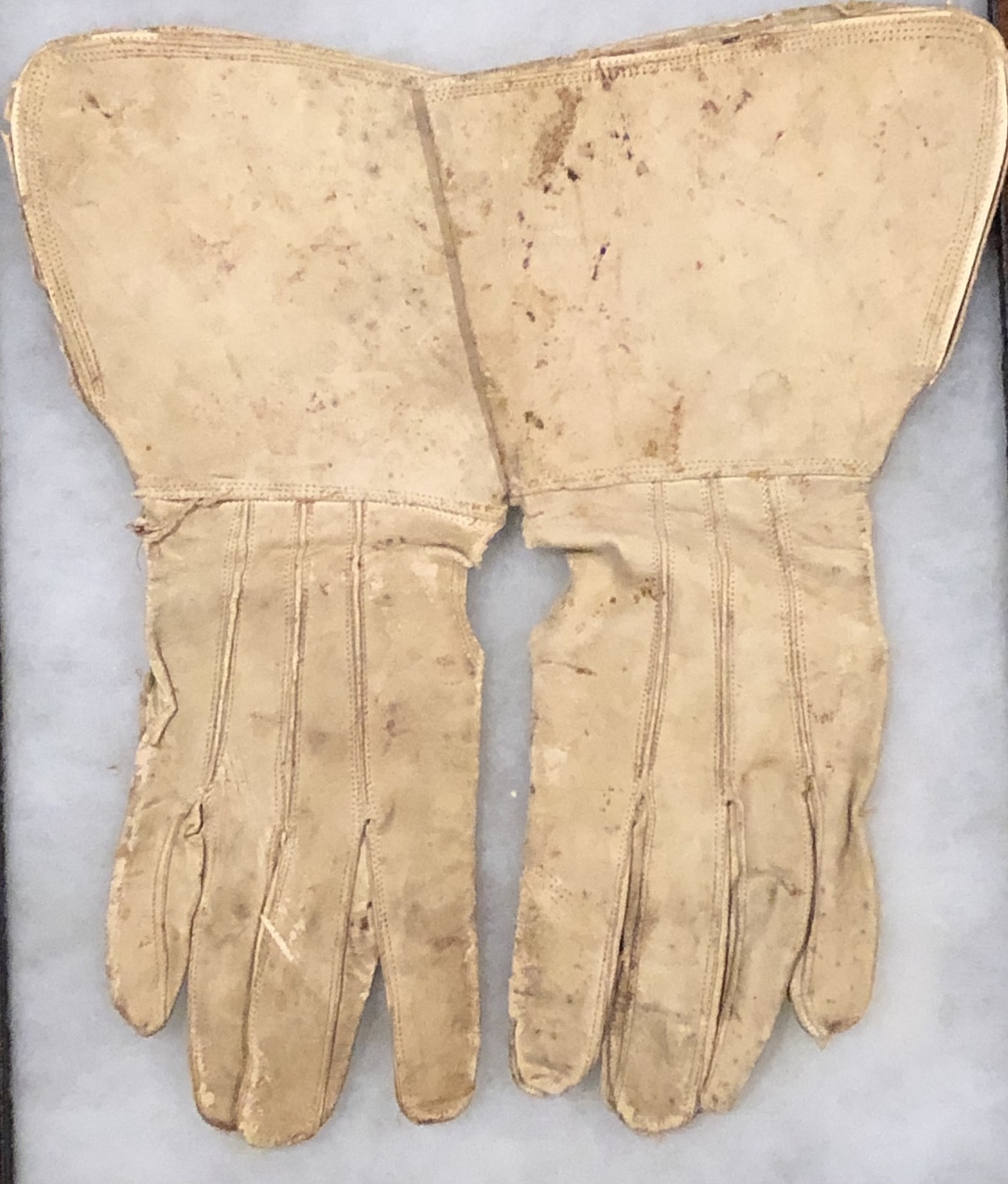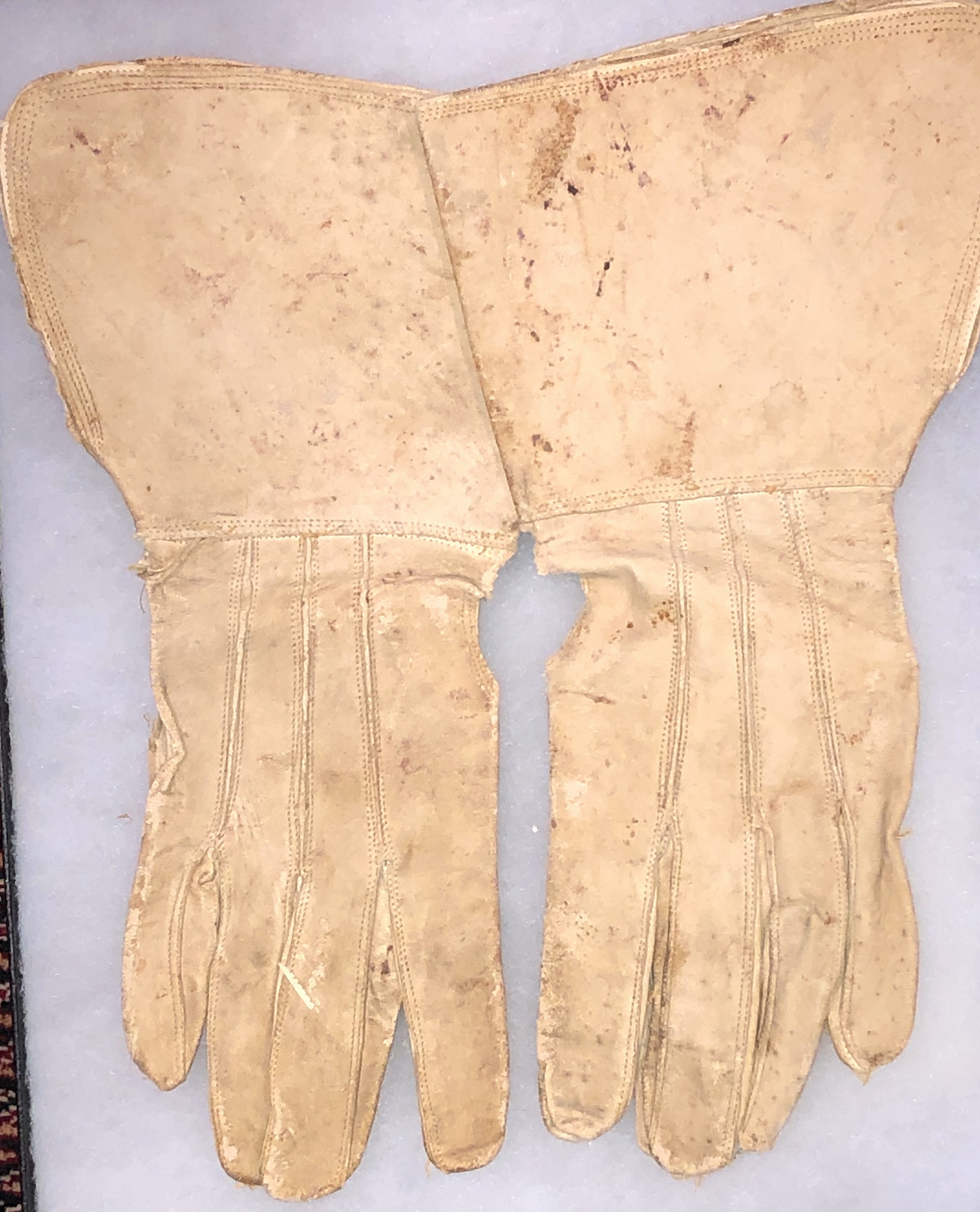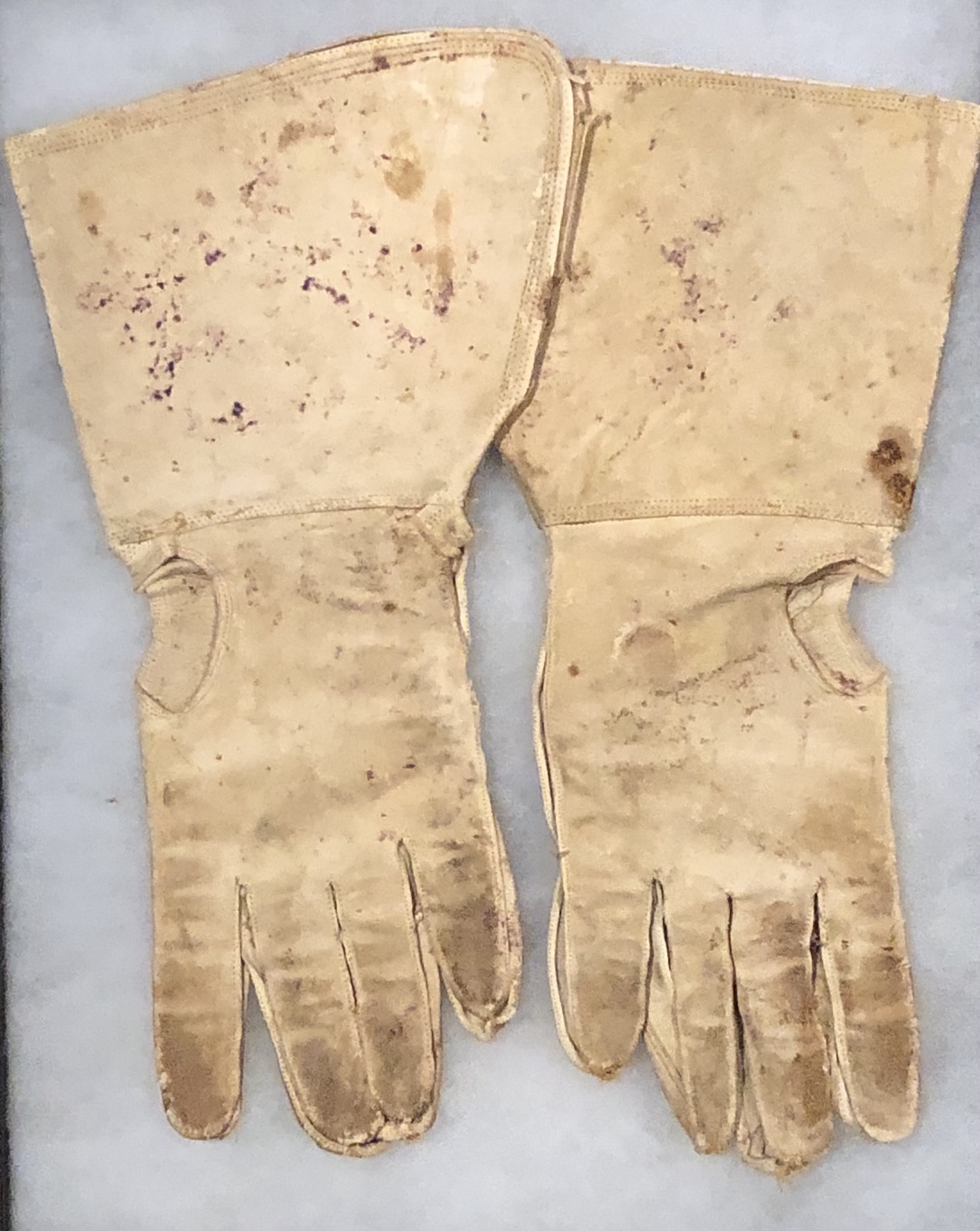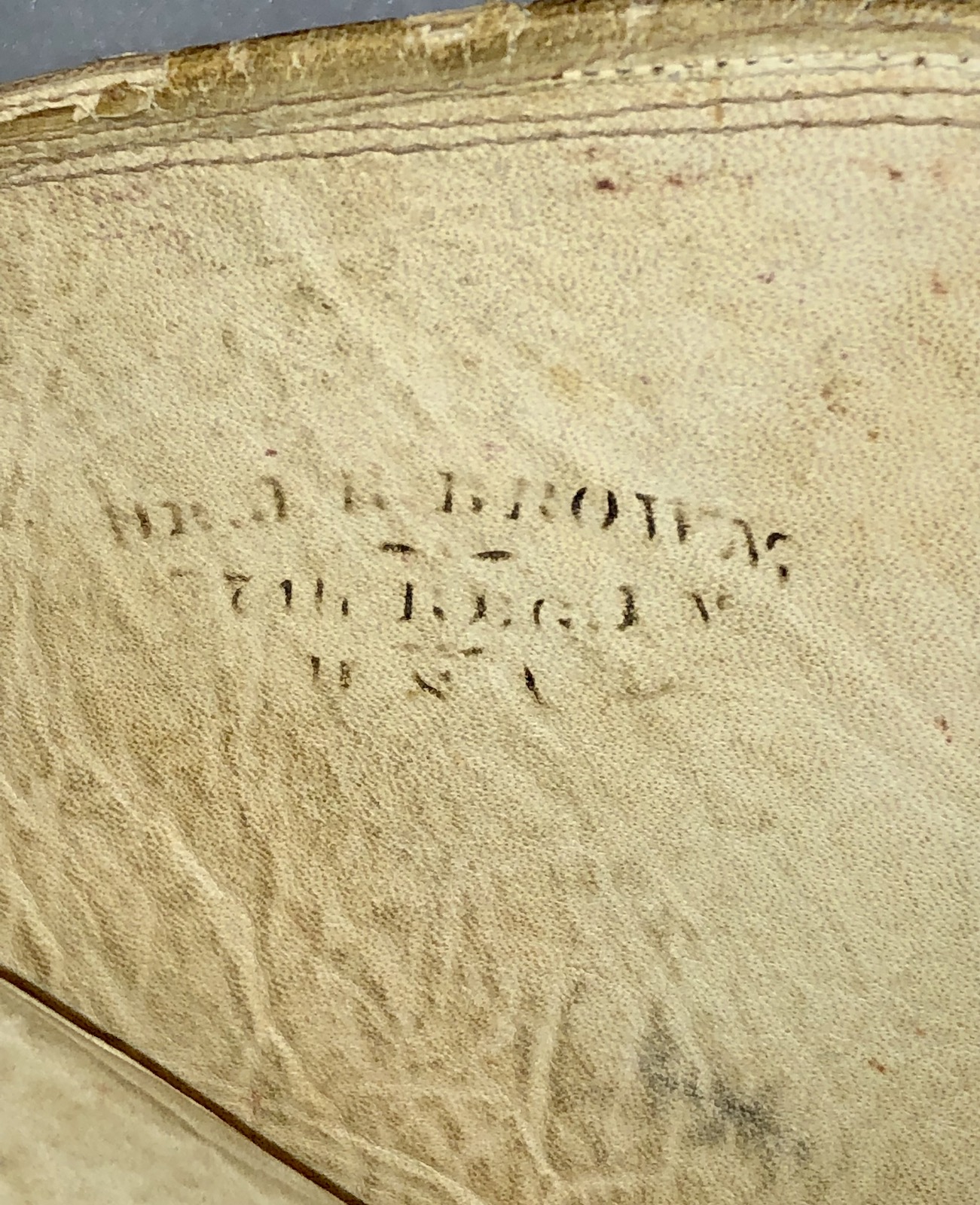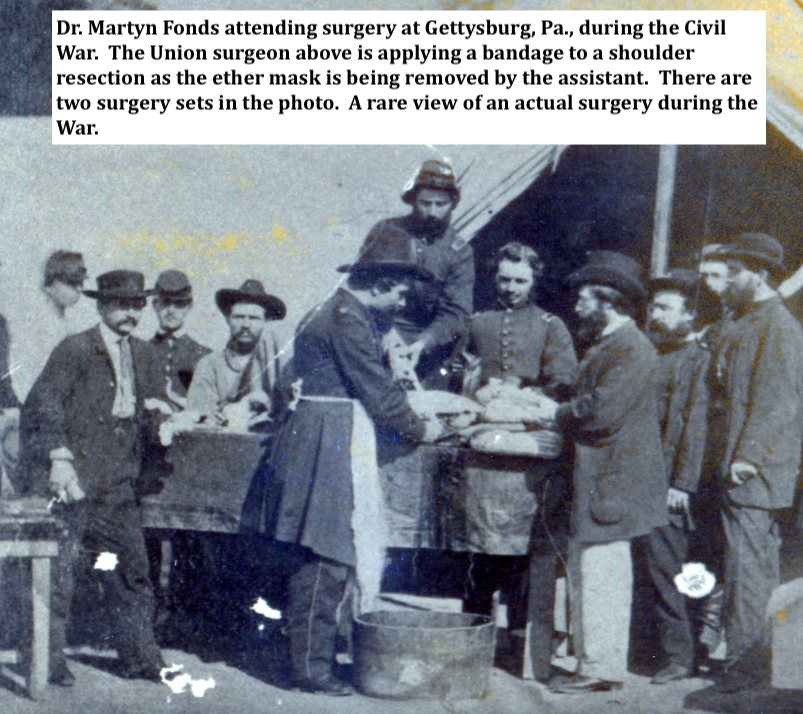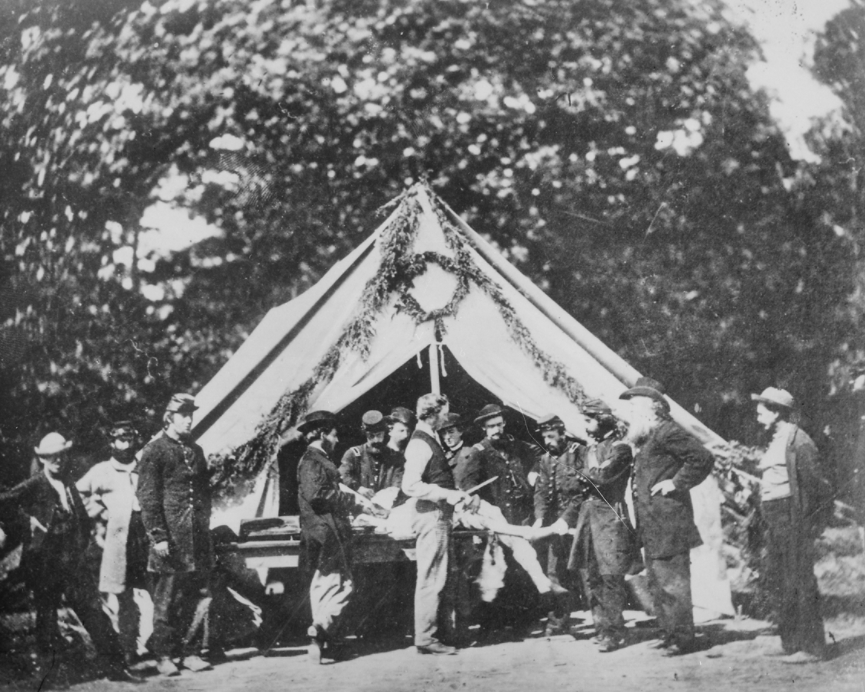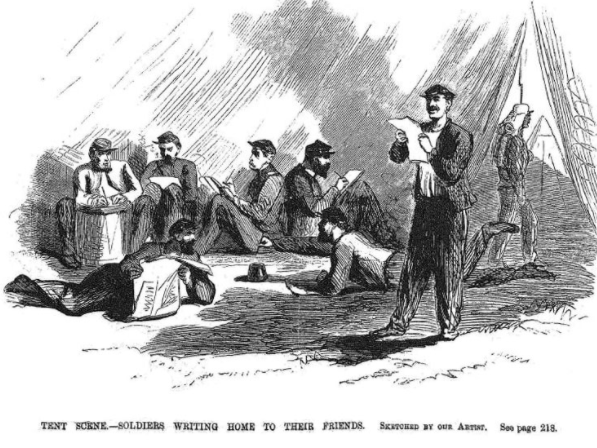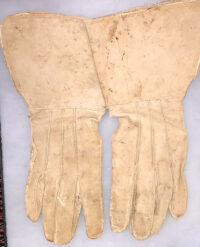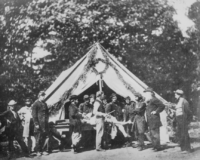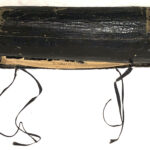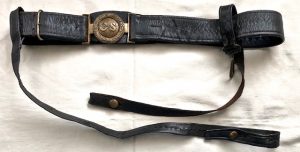Id’d Pair of Civil War Surgeon’s Blood Spattered Gauntlets
SOLD
Id’d Pair of Civil War Surgeon’s Blood Spattered Gauntlets – We have had a few pairs of Civil War gauntlets, although finding a genuine, period pair has become extremely difficult, as most that we see now are either postwar or Masonic, in origin. This pair is definitively Civil War period, as well as identified. In the interior side of both cuffs is stenciling that states:
“DR. J. R. BROWN,
57th I.V.
U.S.A.”
Jesse Brown, from Dalton, Indiana, enlisted as an Assistant Surgeon and was commissioned into the Field & Staff of the 57th Indiana Volunteer Infantry, on November 11, 1861. Accompanying the 57th, Brown would participate in the Battle of Shiloh, where the 57th had multiple casualties; we must presume that Surgeon Brown attended to these casualties, in the field, as these gauntlets are spattered, on both cuffs, with what is, in all likelihood, arterial blood– we have reached this conclusion based upon the medical, physiological fact that arterial blood, under coronary pressure, will “spurt” or spray, as opposed to a venesection that, due to lack of pressure, flows. Dr. Brown artfully and purposefully, had the thumbs removed from both the right and left gauntlets, so as to be able to palpate his patient’s carotid or radial (wrist) pulse. Both gauntlets remain in overall very good condition, with some minor seam openings; the gauntlets are constructed of a fine, buff color, thin leather – the hands of each are soft and supple, while the cuffs were both constructed in a stiffer mode. As mentioned, original Civil War gauntlets are very hard to find now, much less identified; not only are this pair period, but their original owner was a surgeon who saw considerable action during the war. In fact, Surgeon Brown, shortly after Shiloh, resigned, due to purported disability – perhaps, some form of post-traumatic stress, induced by the vicissitudes of combat; he would later re-enlist, in the 124th Indiana, in June of 1864 and accompany that regiment during its participation in the Siege of Atlanta and the Battles of Resaca, Kennesaw Mountain, Franklin and Nashville, Tennessee.
Jesse R. Brown
| Residence Dalton IN;
Enlisted on 10/30/1861 as a Asst Surgeon.
On 11/20/1861 he was commissioned into Field & Staff IN 57th Infantry He Resigned on 4/19/1862 (Resigned, disability) |
57th IN Infantry
( 3-years )
| Organized: on 1/1/62 Mustered Out: 12/14/65 at Port Lavaca, TXOfficers Killed or Mortally Wounded: 6 Officers Died of Disease, Accidents, etc.: 2 Enlisted Men Killed or Mortally Wounded: 97 Enlisted Men Died of Disease, Accidents, etc.: 170 (Source: Fox, Regimental Losses) |
| From | To | Brigade | Division | Corps | Army | Comment |
| Jan ’62 | Jan ’62 | 21 | Army of Ohio | |||
| Feb ’62 | Sep ’62 | 21 | 6 | Army of Ohio | ||
| Sep ’62 | Nov ’62 | 21 | 6 | 2 | Army of Ohio | |
| Nov ’62 | Jan ’63 | 2 | 1 | Left Wing, 14 | Army of Cumberland | |
| Jan ’63 | Oct ’63 | 2 | 1 | 21 | Dept and Army of Ohio and Cumberland | |
| Oct ’63 | Jun ’65 | 2 | 2 | 4 | Dept and Army of Ohio and Cumberland | |
| Jun ’65 | Aug ’65 | 1 | 2 | 4 | Dept and Army of Ohio and Cumberland |
57th Indiana Infantry Regiment
| 57th Regiment Indiana Infantry | |
| Active | November 18, 1861 – December 14, 1865 |
| Country | United States |
| Allegiance | Union |
| Branch | Infantry |
| Engagements | Battle of Shiloh Siege of Corinth Battle of Perryville Battle of Stones River Tullahoma Campaign Siege of Chattanooga Battle of Missionary Ridge Atlanta Campaign Battle of Resaca Battle of Kennesaw Mountain Siege of Atlanta Battle of Jonesboro Battle of Spring Hill Second Battle of Franklin Battle of Nashville |
The 57th Regiment Indiana Infantry was an infantry regiment that served in the Union Army during the American Civil War.
Service
The 57th Indiana Infantry was organized at Richmond, Indiana and mustered in for a three-year enlistment on November 18, 1861.
The regiment was attached to 21st Brigade, Army of the Ohio, January 1862. 21st Brigade, 6th Division, Army of the Ohio, to September 1862. 21st Brigade, 6th Division, II Corps, Army of the Ohio, to November 1862. 2nd Brigade, 1st Division, Left Wing, XIV Corps, Army of the Cumberland, to January 1863. 2nd Brigade, 1st Division, XXI Corps, Army of the Cumberland, to October 1863. 2nd Brigade, 2nd Division, IV Corps, Army of the Cumberland, to June 1865. 1st Brigade, 2nd Division, IV Corps, to August 1865. Department of Texas to December 1865.
The 57th Indiana Infantry mustered out of service at San Antonio, Texas on December 14, 1865.
Detailed service
At Indianapolis until December 23. Left Indiana for Kentucky December 23 and duty at Bardstown and Lebanon, Kentucky, until February 1862. March through central Kentucky to Nashville, Tennessee, February 10-March 13, 1862. March to Savannah, Tennessee, March 21-April 6. Battle of Shiloh, April 6–7. Advance on and siege of Corinth, Mississippi, April 29-May 30. Pursuit to Booneville May 31-June 6. Buell’s Campaign in northern Alabama and middle Tennessee, along Memphis & Charleston Railroad June to August. March to Louisville, Kentucky, in pursuit of Bragg August 21-September 26. Pursuit of Bragg to London, Kentucky, October 1–22. Battle of Perryville, October 8. March to Nashville, Tennessee, October 22-November 7, and duty there until December 26. Near Nashville December 11. Advance on Murfreesboro December 26–30. Battle of Stones River December 30–31, 1862 and January 1–3, 1863. Duty at Murfreesboro until June. Reconnaissance to Nolensville and Versailles January 13–15. Tullahoma Campaign June 23-July 7. Camp near Pelham until August 17. Passage of the Cumberland Mountains and Tennessee River and Chickamauga Campaign August 17-September 22. Occupation of Chattanooga, September 9, and garrison duty there during Chickamauga Campaign. Siege of Chattanooga, September 22-November 23. Chattanooga-Ringgold Campaign November 23–27. Orchard Knob November 23–24. Missionary Ridge November 25. Pursuit to Graysville November 26–27. March to relief of Knoxville November 28-December 8. Operations in eastern Tennessee until April 1864. Operations about Dandridge January 16–17. Atlanta Campaign May 1 to September 8. Demonstrations on Rocky Faced Ridge and Dalton May 8–13. Buzzard’s Roost Gap May 8–9. Battle of Resaca May 14–15. Adairsville May 17. Near Kingston May 18–19. Near Cassville May 19. Advance on Dallas May 22–25. Operations on line of Pumpkin Vine Creek and battles about Dallas, New Hope Church, and Allatoona Hills May 25-June 5. Operations about Marietta and against Kennesaw Mountain June 10-July 2. Pine Hill June 10–14. Lost Mountain June 15–17. Assault on Kennesaw June 27. Ruff’s Station, Smyrna Camp Ground, July 4. Chattahoochie River July 5–17. Buckhead, Nancy’s Creek, July 18. Peach Tree Creek July 19–20. Siege of Atlanta July 22-August 25. Flank movement on Jonesboro August 25–30. Battle of Jonesboro August 31-September 1. Lovejoy’s Station September 2–6. Operations against Hood in northern Georgia and northern Alabama September 29-November 3. Nashville Campaign November–December. Columbia, Duck River, November 24–27. Spring Hill November 29. Battle of Franklin November 30. Battle of Nashville December 15–16. Pursuit of Hood to the Tennessee River December 17–28. Moved to Huntsville, Alabama, and duty there until March 1865. Operations in eastern Tennessee March 15-April 22. At Nashville until June. Ordered to New Orleans, Louisiana, June 16; then to Texas July. Duty at Green Lake and San Antonio until December.
Casualties
The regiment lost a total of 275 men during service; 6 officers and 97 enlisted men killed or mortally wounded, 2 officers and 170 enlisted men died of disease.
Commanders
- Colonel Cyrus C. Hines
- Lieutenant ColonelGeorge W. Lennard – commanded at the battles of Stones River and Chickamauga
- Lieutenant Colonel Willis Blanch – commanded at the battle of Nashville
- MajorJohn S. McGraw – commanded at the battle of Nashville; commanded at the battle of Stones River as captain
Fifty-seventh Infantry INDIANA
(3-YEARS)
|
Fifty-seventh Infantry. — Cols., John W. T. McMullen, Cyrus C. Hines, George W. Lennard, Willis Blanch, John S. McGraw, Lieut.Cols., Franklin A Hardin, George W. Lennard, Willis Blanch John S. McGraw, Timothy H. Leeds; Majs., John W. Jordan, Willis Blanch, John S. McGraw, Joseph S. Stidham, Addison M. Dunn, Timothy H. Leeds, John S. Summers.
This regiment was recruited in the 5th and 11th Congressional districts and was organized at Richmond in Nov. 1861. It was mustered in Nov. 18, and left the state Dec. 23, reporting to Gen. Buell at Louisville, where it was assigned to the 6th division Army of the Ohio, and ordered to Bardstown, Ky.
It moved to Lebanon and on Feb. 12, 1862, to Munfordville and thence to Nashville. It started for Pittsburg landing Mar. 21, and was actively engaged at Shiloh. It participated in the siege of Corinth, and moved from there to northern Alabama, where it remained until July, when it was ordered to Tennessee.
It was on duty near Tullahoma and McMinnville until September and then took an active part in the campaign against Bragg in Kentucky, being in the battle of Perryville. It was at Nashville during most of December, guarding forage trains and engaged in frequent skirmishes. At the battle of Stone’s River it was attached to the left wing of the army and distinguished itself by its gallantry in resisting the fierce attacks made upon the lines at that point, losing 75 in killed and wounded.
It was in camp near Murfreesboro during the winter and spring of 1863 took part in Reynolds’ “eleven days’ scout” in April, and participated in the campaign against Tullahoma. It was in camp near Pelham until Aug. 16, when it joined in the campaign towards Chattanooga and operated on the north side of the Tennessee opposite that city, its brigade taking possession of Chattanooga on its evacuation after the battle of Chickamauga.
Col. Lennard was assigned as provost marshal and the regiment was placed on duty as provost guard. It was in the battle of Missionary Ridge and was then assigned to the 2nd division (Sheridan’s), 4th corps, which formed a part of the column sent to the relief of Burnside at Knoxville.
The regiment reenlisted Jan. 1 1864, and was furloughed home in March. It rejoined the 4th corps May 5, and took part in the Atlanta campaign, being engaged at Rocky Face Ridge, Resaca, where Col. Lennard was mortally wounded, Adairsville, Allatoona, New Hope Church, where it suffered severely and in the heavy skirmishes about Kennesaw Mountain.
In the assault of June 27 it formed the skirmish line in front of the assaulting column of the 4th corps; was on the skirmish line at Peachtree Creek; was then in the trenches before Atlanta until Aug. 25, and was engaged at Jonesboro.
It accompanied its division to Chattanooga, took part in driving Hood into Alabama, and was with Thomas’ army which resisted the enemy’s invasion of Tennessee. It was engaged at Franklin, with heavy loss, especially in prisoners and was in the battle of Nashville, after which it moved to Huntsville, Ala., in pursuit of Hood, remaining there until spring.
It moved into Tennessee in April 1865, proceeding from Bull’s Gap to Nashville, in July was transferred to Texas, being stationed at Port Lavaca, and was mustered out Dec. 14, 1865.
Its original strength was 973; gain by recruits, 464; reenlistments 215; total, 1,652. |
Jesse R. Brown
| Residence Dalton IN;
Enlisted on 6/24/1864 as a Asst Surgeon.
On 6/24/1864 he was commissioned into Field & Staff IN 124th Infantry (date and method of discharge not given) (Declined commission) |
124th IN Infantry
( 3-years )
| Organized: Richmond, IN on 12/1/63 Mustered Out: 8/31/65Officers Killed or Mortally Wounded: 2 Officers Died of Disease, Accidents, etc.: 1 Enlisted Men Killed or Mortally Wounded: 24 Enlisted Men Died of Disease, Accidents, etc.: 128 (Source: Fox, Regimental Losses) |
| From | To | Brigade | Division | Corps | Army | Comment |
| Apr ’64 | Jun ’64 | 1 | 1 | 23 | Army and Dept of Ohio | New Organization |
| Jun ’64 | Aug ’64 | 4 | 3 | 23 | Army and Dept of Ohio | |
| Aug ’64 | Dec ’64 | 2 | 3 | 23 | Army and Dept of Ohio | |
| Dec ’64 | Feb ’65 | 1 | 1 | 23 | Army and Dept of Ohio | |
| Feb ’65 | Mar ’65 | 1 | 1 | Provisional | Department of North Carolina | |
| Mar ’65 | Aug ’65 | 1 | 1 | 23 | Department of North Carolina | Mustered Out |
124th Indiana Infantry Regiment
| 124th Regiment Indiana Infantry | |
| Active | November 1863 – April 30, 1865 |
| Country | United States |
| Allegiance | Union |
| Branch | Infantry |
| Engagements | Atlanta Campaign Battle of Resaca Battle of Kennesaw Mountain Siege of Atlanta Battle of Lovejoy’s Station Battle of Franklin Battle of Nashville Carolinas Campaign Battle of Wyse Fork |
The 124th Regiment Indiana Infantry was an infantry regiment that served in the Union Army during the American Civil War.
Service
The 124th Indiana Infantry was organized at Richmond, Terre Haute, and Indianapolis, Indiana for three-years service beginning in November 1863 and mustered in March 10, 1864 under the command of Colonel James Burgess.
The regiment was attached to 1st Brigade, 1st Division, XXIII Corps, Army of the Ohio, to June 1864. 4th Brigade, 3rd Division, XXIII Corps, to August 1864. 2nd Brigade, 3rd Division, XXIII Corps, to December 1864. 1st Brigade, 1st Division, XXIII Corps, Army of the Ohio, to February 1865, and Department of North Carolina to August 1865.
The 124th Indiana Infantry mustered out of service April 30, 1865.
Detailed service
Left Indiana for Louisville, Kentucky, March 19; then moved to Nashville, Tennessee. Marched to Charleston, Tennessee, April 5–24. Atlanta Campaign May 1 to September 8. Demonstrations on Dalton, Georgia, May 8–13. Rocky Faced Ridge May 8–11. Battle of Resaca May 14–15. Movements on Dallas May 18–25. Operations on line of Pumpkin Vine Creek and battles about Dallas, New Hope Church, and Allatoona Hills May 25 – June 5. Operations about Marietta and against Kennesaw Mountain June 10 – July 2. Lost Mountain June 15–17. Muddy Creek June 17. Noyes Creek June 19. Assault on Kenesaw June 27. Nickajack Creek July 2–5. Chattahoochie River July 5–17. Siege of Atlanta July 22 – August 25. Utoy Creek August 5–7. Flank movement on Jonesborough August 25–30. Near Rough and Ready August 31. Lovejoy’s Station September 2–6. Operations against Hood in northern Georgia and northern Alabama September 29 – November 3. Nashville Campaign November–December. In front of Columbia November 24–27. Columbia Ford November 29. Battle of Franklin November 30. Battle of Nashville December 15–16. Pursuit of Hood to the Tennessee River December 17–28. At Clifton, Tennessee, until January 15, 1865. Movement to Washington, D.C.; then to Morehead City, North Carolina, January 15 – February 24. Carolinas Campaign March 1 – April 26. Advance on Kinston and Goldsboro March 1–21. Battle of Wyse Fork March 8–10. Kinston March 14. Occupation of Goldsboro March 21. Advance on Raleigh April 10–14. Occupation of Raleigh April 14. Bennett’s House April 26. Surrender of Johnston and his army. Duty at Raleigh, Greensboro and Charlotte, North Carolina, until August.
Casualties
The regiment lost a total of 155 men during service; 2 officers and 24 enlisted men killed or mortally wounded, 1 officer and 128 enlisted men died of disease.
Commanders
- Colonel James Burgess – resigned July 9, 1864
- Colonel John M. Orr
One Hundred and Twenty-fourth Infantry
INDIANA
(3-YEARS)
|
One Hundred and Twenty-fourth Infantry. — Cols., James Burgess, John M. Orr; Lieut.-Cols., John M. Orr, Henry H. Neff, Henry S. Gibson; Majs., Henry H. Neff, Henry S. Gibson, John Messick.
This regiment was organized by the consolidation of three companies, raised in the 6th Congressional district for the 125th regiment, and seven companies raised in the 5th Congressional district, rendezvousing at Richmond. It was mustered in March 10, 1864, left the state on the 19th proceeding to Nashville via Louisville, and was assigned to the division command by Gen. Hovey.
On April 5, it proceeded to Athens, Tenn., where the left wing was detached and sent to Columbus. With its corps it marched toward Red Clay, GA, being joined at Columbus by the left wing.
It was in an engagement at Buzzard Roost; in frequent skirmishes in the vicinity of Resaca and Kingston; in sharp fighting at Lost Mountain, and was actively engaged at Kennesaw Mountain. Col. Burgess resigned July 9, and Lieut.- Col. Orr was promoted colonel.
The regiment was in a constant skirmish until Atlanta was reached; was in the battle of Atlanta on the 22nd took part in the siege of Atlanta, fought at Jonesboro, and then remained in camp at Decatur until Oct. 4, when it accompanied the column in pursuit of Hood; had a sharp skirmish at the Oostanaula river; continued the pursuit as far as Gaylesville, Ala. moved via Cedar bluffs and Dalton to Nashville, where it joined Gen. Thomas’ command.
It next moved for Pulaski, reaching there on the 15th and proceeding thence to Columbia, where it was in a brisk skirmish for two days. On the march toward Franklin it was in a brisk fight at Spring Hill, where Co. C was captured.
It was in the battle of Franklin, Nov. 30, repelling every assault, was next engaged in the battle of Nashville, and joined in pursuit of Hood as far as Columbia whence it moved to Clifton, embarked for Cincinnati, moved thence to Washington, which was reached on Jan. 30, 1865; then sailed for Morehead City, N. C., which was reached Feb. 27.
From New Berne, it marched towards Kinston, being engaged at Wise’s Forks, and aiding in repulsing an assault. From Kinston it marched for Goldsboro, where a junction was effected with Sherman’s army on March 21.
It was stationed at Lenoir institute for a short time, moving for Greensboro May 3, thence to Charlotte, where it went into camp. It returned to Greensboro July 13, remained there until Aug. 31, when it was mustered out.
The original strength was 958; gain by recruits 79; total, 1,037. Loss by death, 149; desertion, 37; unaccounted for 6. |


